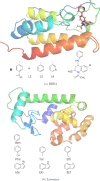Impact of Varying Velocities and Solvation Boxes on Alchemical Free-Energy Simulations
- PMID: 39887323
- PMCID: PMC11863368
- DOI: 10.1021/acs.jcim.4c02236
Impact of Varying Velocities and Solvation Boxes on Alchemical Free-Energy Simulations
Abstract
Alchemical free-energy perturbation (FEP) is an accurate and thermodynamically stringent way to estimate relative energies for the binding of small ligands to biological macromolecules. It has repeatedly been pointed out that a single simulation normally stays near the starting point in phase space and therefore underestimates the uncertainty of the results. Therefore, it is better to run an ensemble of independent simulations. Traditionally, such an ensemble has been generated by using different starting velocities. We argue that it is better to use also other random choices made during the setup of the simulations, in particular the solvation of the solute. We show here that such solvent-induced independent simulations (SIS) sometimes give a larger standard deviation and slightly different results for the binding of 42 ligands to five different proteins, viz. human N-terminal bromodomain 4, the Leu99Ala mutant of T4 lysozyme, dihydrofolate reductase, blood-clotting factor Xa, and ferritin. SIS does not involve any increase in the time consumption. Therefore, we strongly recommend the use of SIS (in addition to different velocities) to start independent simulations. Other random or uncertain choices in the setup of the simulated systems, e.g., the selection of residues with alternative conformations or positions of added protons, may also be used to enhance the variation in independent simulations.
Conflict of interest statement
The authors declare no competing financial interest.
Figures
Similar articles
-
A comparison of different initialization protocols to obtain statistically independent molecular dynamics simulations.J Comput Chem. 2011 Jan 30;32(2):187-95. doi: 10.1002/jcc.21546. J Comput Chem. 2011. PMID: 21132839
-
Can System Truncation Speed up Ligand-Binding Calculations with Periodic Free-Energy Simulations?J Chem Inf Model. 2017 Nov 27;57(11):2865-2873. doi: 10.1021/acs.jcim.7b00324. Epub 2017 Nov 10. J Chem Inf Model. 2017. PMID: 29076739
-
CHARMM-GUI Free Energy Calculator for Absolute and Relative Ligand Solvation and Binding Free Energy Simulations.J Chem Theory Comput. 2020 Nov 10;16(11):7207-7218. doi: 10.1021/acs.jctc.0c00884. Epub 2020 Oct 28. J Chem Theory Comput. 2020. PMID: 33112150 Free PMC article.
-
Studying the Collective Functional Response of a Receptor in Alchemical Ligand Binding Free Energy Simulations with Accelerated Solvation Layer Dynamics.J Chem Theory Comput. 2024 Apr 23;20(8):3085-3095. doi: 10.1021/acs.jctc.4c00191. Epub 2024 Apr 3. J Chem Theory Comput. 2024. PMID: 38568961
-
Are homology models sufficiently good for free-energy simulations?J Chem Inf Model. 2012 Nov 26;52(11):3013-21. doi: 10.1021/ci300349s. Epub 2012 Nov 12. J Chem Inf Model. 2012. PMID: 23113602
References
-
- Kollman P. A.; Massova I.; Reyes C. M.; Kuhn B.; Huo S.; Chong L.; Lee M. C.; Lee T.; Duan Y.; Wang W.; Donini O.; Cieplak P.; Srinivasan J.; Case D. A.; Cheatham T. E. Calculating Structures and Free Energies of Complex Molecules: Combining Molecular Mechanics and Continuum Models. Acc. Chem. Res. 2000, 33, 889–897. 10.1021/ar000033j. - DOI - PubMed
MeSH terms
Substances
LinkOut - more resources
Full Text Sources


